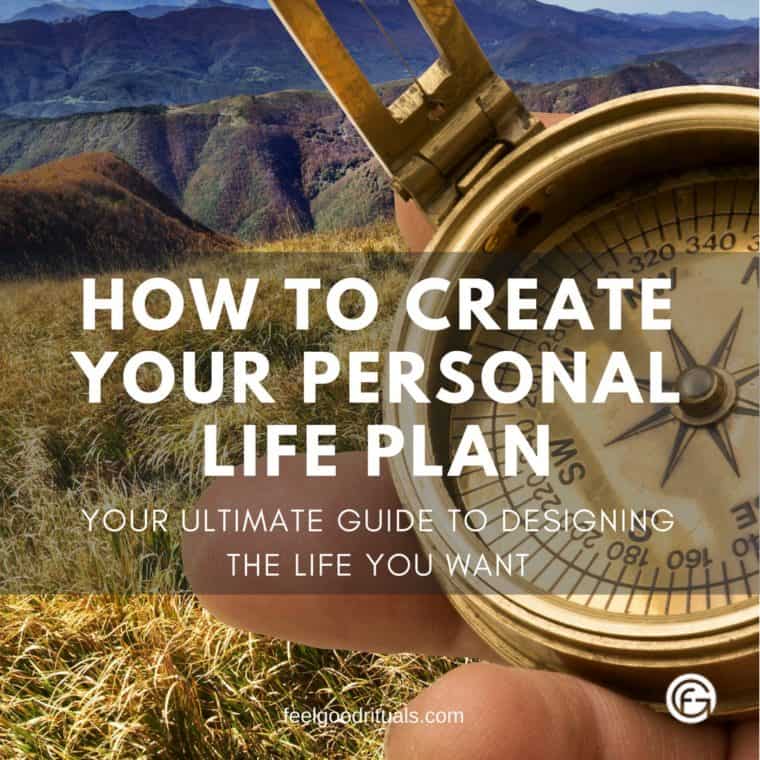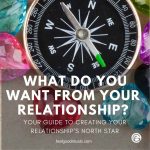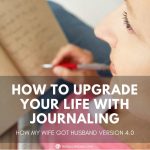Most people have never been asked to contemplate the question “What do you hope to achieve in your life, and what kind of person do you want to be?”
We are used to thinking hard and planning our education, career, and perhaps buying our first home. Heck, we are able to spend countless hours on planning our next summer vacation! But I have met very few people in my life who have a plan for their life.
A Plan For Your Life
When things go well, we don’t think much about our life. Usually there’s no time. Besides, why fix what ain’t broken? But for some of us there comes a day when we wake up discouraged and disillusioned, wondering where we went wrong.
It happened to me too.
During my search for new meaning, I stumbled upon Michael Hyatt. Michael is a New York Times bestselling author, speaker, and blogger who’s working mostly in the field of leadership. I picked up the concept of creating a plan for my life from him. Since then, I’ve been modifying it to have what I have today—and you can read about it.
The experience of creating my personal life plan for the very first time (and then regularly updating it) has been truly transformational. As my wife can attest, my life plan, combined with my weekly journaling routine, changed me in ways I personally could never have imagined.
That’s not all. The beauty is that my life plan still keeps me on track and helps me ensure that my life remains in balance (more or less).
The Outcomes of Your Life
I’m sure you have come across an article published by Guardian, Huffington Post and many other media outlets from a few years ago. It was about Bronnie Ware, an Australian nurse who spent several years working in palliative care, caring for patients in the last 12 weeks of their lives. The title of the article was Regrets of the Dying.
Don’t worry, I’m not going to repeat the article here because that’s not the point. But I want to tell you about the first and most common regret of the dying.
“I wish I’d had the courage to live a life true to myself, not the life others expected of me.”
Ware reported a phenomenal clarity of vision that people gain at the end of their lives, and how we might learn from their wisdom.
Do Only the Dying Have It?
In all honesty, I’m not so convinced that the dying have any special exclusivity on clarity of vision.
Why is it that so many of us put our lives on cruise control? Why do so many of us just cross our fingers and expect things to work out nicely for us?
Well, an obvious answer is that there is not enough motivation. In order to start acting, we need clarity about what we want, why we want it, and a clear direction to go.
If you feel you need a (new) direction in your life, that you want to make some changes, but you don’t (yet) know how, read on. In my experience, a great way to start moving towards the life you want and live true to yourself is to create your own life plan.
In this post I’m sharing my process for creating a life plan. It’s designed to help you imagine your ideal future, access the current reality, and develop a plan for how to close the gap between the two.
3 Steps to Designing the Life You’ve Always Wanted
The process of creating a plan for your life consists of three steps.
- Determine the outcomes you want in your life.
- Decide what matters the most.
- Make an action plan.
Step 1 – Determine the Desired Outcomes
In his book Seven Habits of Highly Successful People, bestselling author Stephen Covey says that Habit 2 is to “begin with the end in mind.”
So let’s do this.
Let’s begin with the end in our mind. Prepare a couple of blank pages and a pencil. Don’t forget to turn off your phone.
How do you want to be remembered by your spouse, your children, friends, and family?
I did this.
Here’s a snippet of the section I wrote, related to my wife Natalie.
When you write this, bear in mind that it is you who’s in focus here. You should write it from the perspective that the others (your spouse, children, friends, and family) are just spectators. That’s because you can control only yourself. You can’t change your spouse, your kids or anyone else. At most, you can influence them.
Step 2 – Decide What Matters the Most
Now you’re going to identify what matters the most to you, and in which order.
In order to make your life plan actionable, you need to know the areas in your life that matter the most to YOU. That’s because your life plan is going to consist of specific actions aimed at specific areas in your life.
Let’s call those areas accounts.
Here are mine: health, inner me, Natalie (my wife), children, career, parents, finances, friends & in-laws, and social life.
Now, prioritize them. Here are my accounts, in order of importance.
- Health
- Inner Me
- Natalie
- Children
- Career
- Finances
- Friends & in-laws, social life
Why would you want to prioritize them?
For example, your career might be going great right now, but you feel your marriage is gradually going south. Maybe, just like in my case, you’re starting to notice you’re gaining way too much weight (and it bothers you, for whatever reason). You might want to reflect on your life plan from time to time and reorder the accounts in order of importance to you (notice the word you).
So prioritization depends on the situation you are currently in. If you’re interested in the state I was in when I created my first life plan, you can read more about it here.
Health
I won’t be of much use to anyone if I’m sick and not feeling well. Therefore, in order to take care of the people I love, I need to take care of myself first. This is why on Mondays, Wednesdays, and Fridays get up at 5:50 AM and go to the gym. This is why my wife and I have our daily walk (almost) every day. This is why I pay attention to what I eat.
Inner Me
The ‘Inner Me’ account is about my inner balance. I achieve it by lots of reading, meditation, playing electric keyboards, writing a weekly journal, and getting enough sleep.
For example, when I created my first life plan I had a toxic sleeping pattern (check out the Living Zombie section in this article). I wanted to change that and so this aspect of my life became part of the action sheet of the ‘Inner Me’ account which will be discussed in the next step.
Taking care of yourself first is not selfish.
There’s no virtue in being a martyr. As the term implies, martyrs always die. (I don’t mean physical death. I mean that after decades of self-neglect, you are dead within.)
If you feel unfulfilled, or you are not content with yourself, if you feel you are not in balance and you’re serving others at the expense of your own well-being, then you need to pay attention to this part. That doesn’t sound like a good plan to me. That’s not a good way to live. Hence, take care of yourself first.
Natalie
I could easily bundle my wife and children into one account called ‘Family,’ but that would be a mistake. That’s because I believe children should not come first, but your spouse. Make no mistake. I love our two boys with every ounce of myself. However, they will be much better off if my wife and I have a fulfilling relationship. I hope my boys will be able to treat their spouses the same.

Children
My children come next. In all honesty, there were times when they weren’t so high on the list. Well, back then, there was no list—but that’s not the point. The career account had been right at the top. I was living with an ever-present feeling of guilt. When I was at home with my kids, I was thinking about my company (yeah, I know). Then again, when I was working, I felt guilty for not coming home earlier. That created a whole lot of problems for me.
Career
As just mentioned, not so long ago, my career was #1 for me. I was sacrificing the other four (my health, my inner self, my wife, and my children) on the altar of my career. Nowadays, my work fulfils me and I love what I do. I work from 7:30 AM to 4:30 PM.
Occasionally, I will work more than this, but for a limited time and for a specific purpose or project. In the afternoon my wife and I usually go for a walk for about an hour, maybe an hour and a half. The rest of the evening is family time. We also always have dinner together. That’s the time when we sit down as a family to have a meal together and talk about how the day went. No phones at the table. I also don’t work on weekends.
Now, I can see why that might not be something you are aiming for, and that’s fine. Your life, your life plan. But you’ve got to have a direction, and you definitely need a life in balance.
Finances
As you can see, finances are not in first place. You might say, “Well, lucky you.” I won’t object.
But I also believe that money is a consequence of the other accounts being in balance. It’s hard to make money if you’re sick. It’s a challenge to remain successful at whatever you do professionally if your marriage is falling apart.
It’s difficult to have a good connection with your children if your basic emotional and physical needs are not met (inner me). Hence, money shouldn’t be a top account in my book. It’s more a consequence than it is a reason.
I consider myself lucky to have grown up in a family that was always prudent with money. So throughout my life it has always been second nature to have a clear overview of our finances.
I always know how much we’re making as a family, how much we’re spending, and what are our limitations are. In that sense, I am the minister of finance in our home.
But this is not all. You don’t need a life plan for that.
As an integral part of my life plan I have clearly identified our financial needs today and for the time when Natalie and I get older (and our children leave the house). I know what I need to do in the next ten years to support our envisioned future of our life together even after many years, and I constantly have that goal in front of me.
Friends
I only have a few close friends who are members of my inner circle. Natalie has two other close friends that can be considered hers (even though I know them well).
But nothing is more satisfying than a few beers and a barbecue with my friends, a dinner, or even a vacation with them. In that regards, last year it was magical. Almost all of my friends gathered together and we spent a few weeks together on the beach.

Step 3 – Create an Action Plan
Here’s where the rubber meets the road. Let’s create an action plan. It consists of one action sheet per account, as identified in Step 2.
Each action sheet consists of four elements:
- A purpose statement
- Your envisioned future
- Your current reality
- Specific commitments
Purpose Statement
That’s your higher reason. It’s like asking yourself, “Why bother, anyway?” Here’s an example of a purpose statement of mine, for my health account:
Your Envisioned Future
The goal is to create a vision of your future self that (all things considered) justifies your effort. Because, as you can imagine, you will need to invest some effort.
You also need to be be as specific as possible. You have to set a clear criteria for success for each of the accounts defined in the last step.
Why?
Well, you need to know how success looks. How else will you know when you’re there?
Instead of writing lots of woulds and shoulds, you’re going to describe your envisioned future like it’s already a reality. In other words, you are going to use present tense.
So, pretend you have already achieved what you wanted.
- What do you see?
- What do you hear?
- How does it feel?
Here’s the envisioned future for my health account.
Now, you might say that this is unrealistic.
I have two things to say. First, this is my life plan, not yours. Yours is going to be different. Secondly, I’m living it. I can’t say that’s going to remain so forever. I can’t run away from aging. But I can slow down the effects of aging dramatically and stay as close to my vision as I can. In that sense, my envisioned future shows a direction.
Your Current Reality
Okay, so now we come to the stage where you hold up a mirror in front of yourself.
What do you see? What’s your current reality?
Be brutally honest. Write in short statements and state facts.
For example, here’s what I wrote when I created my life plan for the first time:
- I am rarely sick.
- I haven’t performed any serious medical health check (heart, arteries) in years.
- I am 6–8 kg (13–17 pounds) overweight.
- I have belly fat that’s growing.
- I drink too much coffee.
See?
There’s no point in hiding things from yourself. Just state the facts as they are so it’s easy to compare that to the next version of your life plan twelve months down the road.
Make Specific Commitments
Here’s where you commit to specific actions you’ll be taking.
- Compare your envisioned future to the current reality.
- Identify gaps.
- Make specific commitments to deal with the gaps.
Example from my action sheet when I first created it
- Enroll to the gym by XX.XX.XX. Work out three times per week.
- Go out for a quick, one-hour walk two times a week. Starting XX.XX.XX
- Four times a week, replace dinners with carbs for meat and vegetables. Starting XX.XX.XX
- Have one coffee in the morning, the rest tea. Starting XX.XX.XX
When I revisit and update my life plan for the next twelve months, I spend most of the time crafting my specific commitments. Why? Because I want to make sure that my commitments are not only specific, measurable (as much as possible) and equipped with a deadline, but that they are attainable and realistic too. This is where most people fail.
For example, when I started working out, I was still responsible for taking the kids to school. That hasn’t changed. But also knew myself enough to know that I needed to exercise in the mornings if I wanted to stick to my new exercising routine.
So, I decided to start waking up at 5:45 AM on Mondays, Wednesdays, and Fridays, go to the gym, work out for 90 minutes, and come home. This would leave me enough time to get back home and take my kids to school.
It’s nice to be optimistic, but following the SMART concept, your commitment also needs to be realistic. Don’t be impatient. There’s only so much you can do in a year, and there are only so many new habits that you can develop in twelve months.
So pick your goals and commitments wisely.
If you’re not sure, break your goals into smaller chunks and select from those. Celebrating small achievements (rather than one big hairy goal) is more fun and gives you needed momentum to stick to the plan. It’s going to be an awesome feeling next year when you see you made some real progress.
Summary Page
This the last section. If you’re like me, then you’re using a word file to create your life plan. So you just copy and paste commitments from all the sections here. The purpose is so you can have an overview of your actions planned for the next 12 months.
How many commitments should you have on your summary page?
It might not seem that way to you. Trust me, it’s not easy to create significant change in seven accounts of your life, no matter how small those are. Therefore, less is more. Don’t try to squeeze everything into one year and end up with twenty commitments.
How to Stick to Your Life Plan
Here are several strategies to make it easier for you to stick to the plan. Because if you don’t, all of the above-mentioned strategies and ideas will remain just a nice wish list.
In terms of sticking to my life plan, here’s what works for me.
- Print out the summary page. If you use my template, then you’re probably going to have your life plan saved in word format. My guess is that you’re not going to read your life plan every day. I sure don’t. And you don’t need to. Instead, print out the summary page and put it somewhere close by, in your own space. In my case that would be my desk. This way, you’ll have your commitments and goals frequently in front of your eyes which makes it easier to keep them fresh in your mind.
- Set up alerts. There is a very high chance that your new specific commitments will require you to develop some new habits. As we all know, forming new habits is hard. It’s even harder to stick to them. Here’s a quick way to make it easier for you: create alerts in your phone. For example, in account ‘children’ I had a commitment that said “Mention something good and give praise to your two boys.” (Without going into too much detail, the background here is that I discovered that I was focusing too much on things that didn’t work, while taking the positive stuff for granted. Does that sound familiar?) So, as my specific step in the direction of my envisioned future I set up an alert on my phone just before dinner saying ’Nick, Alex, praise.’ Then I would think and come up with something that I could give both boys praise for.
- Buy a giant wall calendar. Now that you have your summary page with specific SMART commitments, put the relevant ones into a calendar. I do that. Why? Well, after a while I’m not going to notice that anymore. But my subconscious is going keep seeing it.
- Create a vision board. This is where you can pin photos that symbolize things you want to see realized. I still have my vision board from 2014; it still holds true today. It’s on the wall in my home office where I work. Every photo has a meaning. Every photo supports a particular part of the vision for my life and the outcomes I want to see happen. You can buy a wooden frame at WalMart. Mine has enough places for twelve photos. It’s quite big (3 ½ x 2 ½ feet), so my subconscious definitely notices it every time I pass by.

My vision board on the wall in my working room.
- Write a weekly journal. Here’s the journaling template that changed my life, and made me a better father, husband, and friend.
- Talk with others. Talk to people who share your goals and dreams to stay encouraged and excited. Every time I share my dreams, people get excited. That’s because it’s pretty rare to stumble upon someone who can clearly articulate their vision for life. If you follow the advice of this post, you’ll be one of those people.
A Yearly Reflection
A life plan that was created once and is never updated is worth very little. Therefore, if you seriously want to change your life for the better, you need to stick to a routine. I recommend blocking off two to three days for your yearly reflection, but two at minimum.
Here’s what I do.
Day 1
I dedicate the first day to my reflection about the past year. That’s a very important step. How so? Well, you need to know if you are on course. You also have to know if your course is still the same, or whether it needs a correction because your goals have changed. Most of all, you need a good pat on your back. A pat you’ll give to yourself.
Think of it like mental candy.
Here are the prompt questions I use when I reflect on the year:
- If there was a newspaper headline describing this past year for you, what would it say?
- What are you most proud of in the last year?
- What things did you do for the first time during the past twelve months? On that note, when was the last time you did something for the first time? (Think about that and make sure there’s something new every year. Admittedly, with years it gets more and more difficult to find something. That’s exactly the point!)
- What new things did you learn?
- What unfinished business did you want to resolve before the year’s end, and when will you do it?
- When were you most excited about life in this past year? What were you doing? Who were you with?
- What new dream for yourself did you achieve?
- What new and inspiring people did you meet in the last year? Who do you want to get closer with in the year to come? (Remember, you are the average of the five people you spend most time with. Choose wisely!)
- Looking back, what would you have done differently in the past year?
- Where did you let fear hold you back from a goal you had?
- What was boring? What was sucking your life energy too much, and you hope to change that for next year?
- What were outright failures, and what are lessons learned?
Day 2
The second day is dedicated to updating your life plan.
I revisit my outcomes in life and then go from account to account. I compare the current reality to the one that was written a year ago. You’ll be astonished how many changes for the better you’ll notice. Most of them will not be earth-shattering, but in your heart, you’ll know that you’re on the right track. (And that, my friend, is the most important thing.)
Finally, I develop a new set of specific commitments for the next year, and so I finish the yearly life planning cycle.
Lastly, for your yearly reflection and update to your life plan, here’s my advice. Really block off the days and plan nothing else for this time.
Pick a peaceful spot somewhere you know you definitely won’t be disturbed. This is very important. Rent a remote cottage or check into a motel out of town and do your thing.
You need some time for yourself. You need peace, trust me. It’s worth it.
The Results
Creating a life plan is not a magic bullet. But it’s a great tool to get you going in the right direction. After a year you’ll review your life plan and you’ll be able to compare it to the new current situation.
I always find that some goals were not achieved. Then again, some others were and some have exceeded my expectations. That’s totally normal. You can’t know one year in advance how life will unfold.
No one has a crystal ball, and neither do you. But you are going in the right direction. And, if not, at the very least, you know it. You are not fooling yourself. You can actually measure your progress towards the life you always wanted. So don’t be too harsh on yourself.
Just keep going.












Wonderful, what a weblog iit is! This website gives valuable fadts to
us, keep it up.
Thanks Lino!, I’m glad you love my work! 🙂 Cheers, Marko